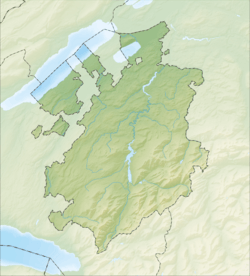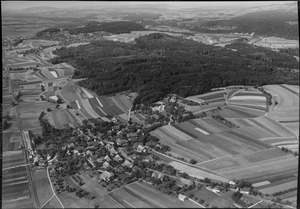Fräschels facts for kids
Quick facts for kids
Fräschels
|
||
|---|---|---|
|
||
| Country | Switzerland | |
| Canton | Fribourg | |
| District | See | |
| Area | ||
| • Total | 3.11 km2 (1.20 sq mi) | |
| Elevation | 457 m (1,499 ft) | |
| Population
(Dec 2020 )
|
||
| • Total | 456 | |
| • Density | 146.6/km2 (379.8/sq mi) | |
| Postal code |
3284
|
|
| Surrounded by | Kallnach (BE), Kerzers, Niederried bei Kallnach (BE) | |
Fräschels is a small town, also called Frasses in French. It is a municipality located in the canton of Fribourg, in Switzerland. It's part of the See district.
Contents
Exploring the History of Fräschels
Fräschels was first mentioned in old records way back in 1225. At that time, it was known as Frescin. Just a few years later, in 1228, it was called Frasses in French documents.
Understanding Fräschels' Geography
Fräschels covers an area of about 3.1 square kilometers (1.2 square miles). A big part of this land, about 71.3%, is used for farming. Forests cover another 17.2% of the area.
About 10.5% of the land is built up with buildings and roads. A small part, 0.6%, includes rivers or lakes. The rest, 0.3%, is land that isn't used for farming or building.
Where is Fräschels Located?
This municipality is in the See/Lac district. It is the northernmost town in the Fribourg canton. Fräschels is about 10 kilometers (6 miles) north of Murten. It sits on the eastern edge of the Grosses Moos marshlands.
What Does the Fräschels Coat of Arms Look Like?
The official coat of arms for Fräschels shows a black milestone (a stone marker) with white lines. It stands between two green alder trees. All of this comes out of a green base.
Who Lives in Fräschels? (Demographics)
Fräschels has a population of about 500 people. Most people in Fräschels speak German as their main language. About 95% of the residents speak German.
A smaller number of people speak Macedonian (about 2.1%) or French (about 0.8%). There are also a few people who speak Italian.
Population Details
In 2008, about 7% of the people living in Fräschels were foreign nationals. The population has changed a little over the past 10 years, growing by about 1%.
More than half of the population (53.2%) are male, and 46.8% are female. About 31.8% of the people living in Fräschels in 2000 were born there.
Age Groups in Fräschels
Children and teenagers (ages 0–19) make up about 28.5% of the population. Adults (ages 20–64) are the largest group, at 57.8%. Seniors (over 64 years old) make up 13.7% of the population.
Households and Families
In 2000, there were 173 private households in Fräschels. On average, each household had about 2.8 people. About 32 households had only one person, and 17 households had five or more people.
The historical population of Fräschels is shown in the chart below:

Economy and Jobs in Fräschels
In 2010, the unemployment rate in Fräschels was very low, at just 1%. Many people work in different types of jobs.
Main Job Sectors
- Primary Sector: This includes jobs like farming. About 55 people work in this sector, with 16 businesses.
- Secondary Sector: This involves manufacturing and construction. About 14 people work here, with 5 businesses.
- Tertiary Sector: This covers services, like hotels, restaurants, and education. About 31 people work in this sector, with 9 businesses.
Overall, 272 residents of Fräschels are employed. About 41.9% of the workforce are women.
Commuting to Work
Many people who live in Fräschels travel to other towns for work. In 2000, 178 workers left the municipality for their jobs. Only 19 workers came into Fräschels for work. Most people (55.5%) use a private car to get to work, while 14.7% use public transportation.
Religion in Fräschels
Based on the 2000 census, most people in Fräschels belong to a Christian church. About 71.5% are part of the Swiss Reformed Church. Another 8.5% are Roman Catholic.
Some people belong to other Christian churches, including Orthodox churches. A small number of people are Islamic or Jewish. About 11.85% of the population do not belong to any church.
Weather in Fräschels
Fräschels experiences about 124 days of rain or snow each year. On average, it gets about 990 millimeters (39 inches) of precipitation annually.
The wettest month is June, with about 105 millimeters (4.1 inches) of rain or snow over 11.1 days. May has the most days of precipitation (13 days), but with less rain. February is the driest month, with about 66 millimeters (2.6 inches) of precipitation over 9.8 days.
Education in Fräschels
Many adults in Fräschels have completed a good level of education. About 37.2% have finished non-mandatory upper secondary education. Another 16% have completed higher education, like university or a specialized college.
Swiss School System
The Canton of Fribourg has a specific school system:
- Kindergarten: One year, not required.
- Primary School: Six years, required.
- Lower Secondary School: Three years, required. Students are grouped by their abilities.
- Upper Secondary School: Three or four years, optional. This can be a gymnasium (for university) or a vocational program (for specific jobs).
- After upper secondary, students can go to a Tertiary school or start an apprenticeship.
Local Schooling
During the 2010–11 school year, 45 students attended 2 classes in Fräschels. While there were no kindergarten or lower secondary classes in Fräschels itself, students from the municipality attended these schools in nearby towns.
Transportation in Fräschels
Fräschels has its own railway station, called Fräschels. This station is on the Palézieux–Lyss line. You can catch regular trains from here to Kerzers and Lyss.
See also
 In Spanish: Fräschels para niños
In Spanish: Fräschels para niños





